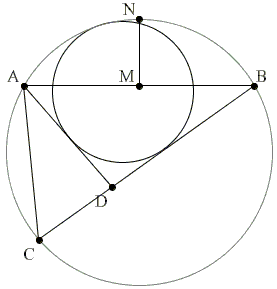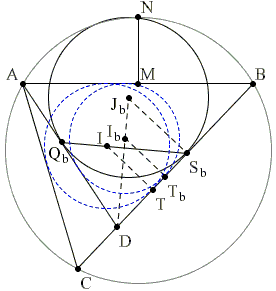A Hard but Important Sangaku
ABC is a given triangle, and circle O(R) passes through A and B, C lying within the circle. The circle O'(x) lies within O(R), touches AC and BC and also touches

|
Show that
| x = r + 2d(s - a)(s - b) / cs, |
where s is the semiperimeter of ΔABC and r is the radius of the incircle of ΔABC.
The problem is listed as 2.2.8 by Fukagawa and Pedoe and said to be hard but important because of its relevance to a variety of other sangaku. It comes from a third volume of a 1781 collection Seiyo Sanpo by Teisi Fujita (1734-1807).
The solution below is by a New York physicist who posted it under the pseudonym yetti at the MathLinks Forums.
An alternative solution was found by James M. Unger, Professor of East Asian Languages & Literatures, The Ohio State University, Columbus, Ohio.
References
H. Fukagawa, D. Pedoe, Japanese Temple Geometry Problems, The Charles Babbage Research Center, Winnipeg, 1989, pp. 101-102
Write to:
Charles Babbage Research Center
P.O. Box 272, St. Norbert Postal Station
Winnipeg, MB
Canada R3V 1L6
|Contact| |Front page| |Contents| |Geometry|
Copyright © 1996-2018 Alexander Bogomolny
First extend, say, BC to cut O(R) in P:

|
This brings the problem into the framework of one of V. Thébault's theorems and suggests a change of notations.

|
Further (re)define a = BC,
|
sb + |
The incenter of ΔABC will be denoted I, the incircle (I). For ΔABD, the incenter is Ib, the incircle (Ib) and the inradius rb. We also consider the curvilinear triangles ABD and ACD with the incenters Jb and Jc and incircles (Jb) and (Jc). Note that the unknown x is the radius of (Jb).
In these notations, we want to show that
| (1) | x/rb = 1 + 2·MN·(sb - u)(sb - d) / crbsb. |
Using Heron's formula for ΔABD, viz.,
| Area( ΔABD)² = sb(sb - u)(sb - d)(sb - c) |
we transform (1) into the equivalent
| (2) |
|
Let now T, Tb, Sb denote the points of tangency of (I), (Ib) and (Jb) with BC and Qb that of (Jb) and AD. By Sawayama's Lemma, I, Sb and Qb are collinear. By definition,

|
If
| TSb = IT· tan(φ) = r · tan(φ). |
With this in mind,
| DTb = sb - c, |
whereas,
|
Using x = DSbtan(φ) and rb = DTbtan(φ),
|
Using
|
we see that
| (3) | x / rb - 1 = [r · tan(φ) - (sc - b)] / (sb - c). |
We have now to show that the right hand side in (3) coincides with the right hand side in (2):
| [r · tan(φ) - (sc - b)] / (sb - c) = 2·MN· rb / c(sb - c) |
which is the same as showing that
| (4) | r · tan(φ) = 2·MN· rb / c + (sc - b). |
Observe that
| ∠MAN = ∠BAN = ∠BCN = ∠ACB / 2 |
implying
|
from ΔICT. Also, from ΔABD,
| tan(φ) = rb / (sb - c), |
the combination of which reduces (4) to the equivalent
| (5) | rrb / (sb - c) = rrb / (s - c) + sc - b. |
Using (s - c) - (sb - c) = s - sb = sc - d (5) becomes
| (6) | rrb(sc - d) / (sb - c)(s - c) = sc - b. |
But now again r / (s - c) = tan(∠ACB / 2) = rc / (sc - d) which further upgrades (6) to
| rbrc / (sc - b)(sb - c) = 1 |
which is the same as
| (7) | rb / (sb - c) × rc / (sc - b) = 1. |
However, rc / (sc - b) = tan(ψ) where ψ = ∠ADC/2. So that (7) merely asserts that
Since (7) holds, the equivalent (1) is also true.
Sangaku
- Sangaku: Reflections on the Phenomenon
- Critique of My View and a Response
- 1 + 27 = 12 + 16 Sangaku
- 3-4-5 Triangle by a Kid
- 7 = 2 + 5 Sangaku
- A 49th Degree Challenge
- A Geometric Mean Sangaku
- A Hard but Important Sangaku
- A Restored Sangaku Problem
- A Sangaku: Two Unrelated Circles
- A Sangaku by a Teen
- A Sangaku Follow-Up on an Archimedes' Lemma
- A Sangaku with an Egyptian Attachment
- A Sangaku with Many Circles and Some
- A Sushi Morsel
- An Old Japanese Theorem
- Archimedes Twins in the Edo Period
- Arithmetic Mean Sangaku
- Bottema Shatters Japan's Seclusion
- Chain of Circles on a Chord
- Circles and Semicircles in Rectangle
- Circles in a Circular Segment
- Circles Lined on the Legs of a Right Triangle
- Equal Incircles Theorem
- Equilateral Triangle, Straight Line and Tangent Circles
- Equilateral Triangles and Incircles in a Square
- Five Incircles in a Square
- Four Hinged Squares
- Four Incircles in Equilateral Triangle
- Gion Shrine Problem
- Harmonic Mean Sangaku
- Heron's Problem
- In the Wasan Spirit
- Incenters in Cyclic Quadrilateral
- Japanese Art and Mathematics
- Malfatti's Problem
- Maximal Properties of the Pythagorean Relation
- Neuberg Sangaku
- Out of Pentagon Sangaku
- Peacock Tail Sangaku
- Pentagon Proportions Sangaku
- Proportions in Square
- Pythagoras and Vecten Break Japan's Isolation
- Radius of a Circle by Paper Folding
- Review of Sacred Mathematics
- Sangaku à la V. Thebault
- Sangaku and The Egyptian Triangle
- Sangaku in a Square
- Sangaku Iterations, Is it Wasan?
- Sangaku with 8 Circles
- Sangaku with Angle between a Tangent and a Chord
- Sangaku with Quadratic Optimization
- Sangaku with Three Mixtilinear Circles
- Sangaku with Versines
- Sangakus with a Mixtilinear Circle
- Sequences of Touching Circles
- Square and Circle in a Gothic Cupola
- Steiner's Sangaku
- Tangent Circles and an Isosceles Triangle
- The Squinting Eyes Theorem
- Three Incircles In a Right Triangle
- Three Squares and Two Ellipses
- Three Tangent Circles Sangaku
- Triangles, Squares and Areas from Temple Geometry
- Two Arbelos, Two Chains
- Two Circles in an Angle
- Two Sangaku with Equal Incircles
- Another Sangaku in Square
- Sangaku via Peru
- FJG Capitan's Sangaku
|Contact| |Front page| |Contents| |Geometry|
Copyright © 1996-2018 Alexander Bogomolny
73578397
